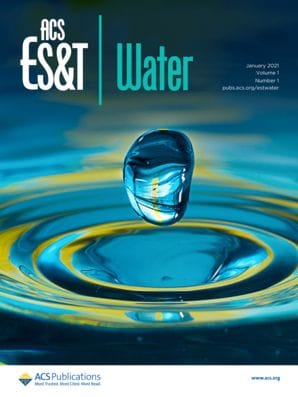In this interview, Editor-in-Chief Shane Snyder reflects on the journal's remarkable journey so far and what lies ahead for water research and policy.

Five years ago, ACS ES&T Water launched with a vision to serve as a global platform for transformative research in water science, technology, and policy. Since then, it has grown into a leading voice in the field—championing breakthroughs, nurturing interdisciplinary collaboration, and shaping conversations around water sustainability.
To mark this milestone, we sat down with Prof. Shane Snyder, Editor-in-Chief of ACS ES&T Water, to reflect on the journal’s remarkable journey. From the challenges and triumphs of its early days to the role it plays in today’s rapidly evolving environmental landscape, Prof. Snyder offers candid insights and a compelling look at what lies ahead for the journal and the broader water community.

The Journey of ACS ES&T Water
What inspired the launch of the journal, and what gap did it aim to fill in the research landscape?
Building on the strong legacy and prominence of Environmental Science & Technology (ES&T), ACS ES&T Water was conceived as a unique offering within the ACS family of journals that would be solely focused on water research, policy, and case studies. The aim was to be a central outlet for the broad aspects of water challenges as well as novel and applied solutions. The dissemination of scientific, policy, and case studies provides an opportunity to also dive deeper into regionally important topics yet with dissemination globally where others can adapt and build upon these findings. Our journal is also keen to publish reviews, perspectives, and viewpoints that provide authors with a wide range of mechanisms to share their data, experience, and opinions regarding water issues and remedies.
What were some of the biggest challenges in establishing the journal, and how were they overcome?
Launching a new journal is not a trivial task. We were very fortunate to recruit three highly experienced associate editors and to quickly establish an editorial advisory board with broad expertise and geographical distribution. However, the greatest challenge was attracting submissions to a new journal which would not have an impact factor until the third year. We understand many academic institutions rely only upon high-impact journals for promotion and tenure advancement. Thus, we took a proactive and inclusive approach to solicit submissions from authors around the world. Indeed, as a team, we were widely successful and have published manuscripts from nearly 60 countries.
Are there any standout moments or personal highlights from the past five years?
As the journal evolved and developed over the past five years, there were several key moments that I remember in particular. The most impactful was to receive the ACS Publications award of fastest growing young journal (defined as being 5 years or less since its launch) for ACS ES&T Water, presented at the 2023 ACS Publications Conference of Editors in San Diego. During this award ceremony, I had no idea that ACS ES&T Water would receive an award, thus I was quite surprised when announced. An earlier highlight was the announcement of our first Journal Impact Factor™ in the summer of 2023, which caused a rapid and sustained surge of submissions likely resulting in the award aforementioned. While growing our impact factor was not our key priority, it was an important milestone and surely impacted submissions. However, increased submissions consequentially resulted in increased workload, thus the recruitment of new editors and editorial advisory board members are also highlights of the past five years.
Scientific and Editorial Evolution
How has the field of water research evolved over the past five years?
The fields of water research and water policy continue to evolve at a rapid pace, which is why ACS ES&T Water has experienced tremendous growth every year since the launch of the journal in 2020. Over the past five years, some topics have uniquely increased in submissions, publications, and citations for ACS ES&T Water. Among those topics, wastewater-based epidemiology (WBE) type studies which track human disease from microbiological or chemical occurrence in sewage has grown immensely. Fueled largely by the COVID pandemic, researchers and policy makers have shared numerous methodological and case study manuscripts on WBE efforts. Another example has been the tremendous uptick in submissions on polyfluorinated alkyl substances (PFAS), which was in part catalyzed by the US Environmental Protection Agency updated health advisory levels followed by drinking water regulations. We also experienced a large increase in manuscripts regarding plastic particles in water, including those originating from automotive tire wear. Yet another example is the immense growth in machine learning and artificial intelligence (AI). ACS ES&T Water published a curated Collection on the use and optimization of these tools for water treatment and water quality assessment. Finally, there has been an increasing interest in sustainability in water systems, including optimization of treatment processes as well as decarbonization of engineered systems in general.
What role does the journal play in advancing interdisciplinary and emerging research areas?
By remaining open to water research topics across the disciplines and securing editors with diverse expertise, ACS ES&T Water has been able to widely advance emerging themes of within the broad domain of water science, research, and policy. Over the past five years, we have brought in new editors with expertise in water policy, biological technologies, pathogen occurrence and treatment, and machine learning/AI. Furthermore, we have been proactive in identifying topics where special issues would have strong impact and influence. These special issues generally involve guest editors and other champions who help disseminate the call for submissions and review the manuscripts received. I am very proud of our special geographical issues, which solicited for submissions from all countries in Southeast Asia and South Asia, where we successfully connected with authors who often had not published with ACS previously. The geographical special issues will continue, and we hope to have representations from all countries, with an emphasis on reaching lesser represented geographies.
Looking Forward: The Next Five Years
What are the key research trends that will shape the future of water research?
It is difficult to forecast where water research and policy will go in the future; however, with our global representation of editors, board members, and authors we have a massive network from which we continually monitor. Moreover, we will be recruiting more editors in the coming months, which will further increase our network, expertise, and bandwidth.
Regardless, certain trends are very likely to see continued and rapid growth over the next five years. For instance, water reuse is growing at a staggering rate, and ACS ES&T Water received many manuscripts regarding engineering, monitoring, and safety considerations of potable and non-potable reuse systems. Likewise, and related, we expect to see continued growth in the area of industrial water treatment. Industrial systems include novel water reuse schemes and resource recovery, among others.We also expect to see continued growth in novel alternative methods (NAMs) for toxicity screening and effects-based analyses (EBA) coupled with non-targeted analyses for specific chemical structure identification. The future is bright for ACS ES&T Water and we look forward to the growth and will continue to adapt and evolve to better meet the needs of our authors and interests of our readers.
How can ACS ES&T Water continue to grow its impact and global reach?
ACS ES&T Water already has experienced amazing growth and impact, yet we will continue to drive for increased submissions from even more countries. This involves a continually proactive approach of inviting more authors to contribute to the journal and to introduce our team to their colleagues. Indeed, all of us as editors have the privilege to attend conferences and visit academic and government institutions on all corners of the earth. We also will continue to encourage our global colleagues to serve as peer-reviewers, advisory board members, and even associate editors. Considering the growth so far, I am positive that the future is bright in terms of growing the journal to new levels of impact and global reach.
What advice would you give to early-career researchers looking to contribute to the journal?
I strongly believe that early-career researchers are extremely vital for the journal’s success. Clearly, early-career colleagues have the most recent knowledge and experience within their fields of expertise. In addition, we often notice that early-career researchers are more amenable to conducting peer-reviews while also generally contributing exceedingly detailed and thorough evaluations. We also have included early-career researchers within our editorial advisory board and we have plans to increase the number and diversity going forward.
My best suggestion is to be proactive. Write to the editors and volunteer to peer-review, and when selected remain judicious regarding the deadline for submitting the review and of course provide an objective, detailed, thorough evaluation. It is great to voice interest in joining the editorial advisory board or associate editor team; however, we will evaluate the track record of potential editors for publication and peer-review contributions in terms of quantity and quality. Again, the best way to contribute is to reach out directly to the editors and to offer to serve as a peer-reviewer, then following through with an on time and technically detailed review.
Finally, ACS ES&T Water has published some noteworthy research in the past five years. Could you identify five of your personal favorites (one for each year) and share what made each of them stand out to you?
It is extremely difficult to select my favorite publications from ACS ES&T Water, as there are so many excellent and impactful publications every month. However, as described previously, several key topics elicited multiple submissions that were impactful:
- In 2021, we published a manuscript by Werbowski, et al. entitled, “Urban Stormwater Runoff: A Major Pathway for Anthropogenic Particles, Black Rubbery Fragments, and Other Types of Microplastics to Urban Receiving Waters.” While we received several excellent manuscripts related to microplastic characterization and fate, this manuscript regarding urban storm water from 12 watersheds that enter the San Francisco Bay was particularly intriguing. This study showed that urban runoff generally had greater concentration of microplastics as compared to wastewater treatment plant effluents. The study also suggested “rubbery fragments” as a new type of microplastics, attributed predominantly to automotive tires. Also, the study showed that rain gardens, which filtered the stormwater using soil and vegetation, was capable of removing the vast majority of microplastics.
- In 2022, ACS ES&T Water published numerous articles related to monitoring of the SARS-CoV-2 virus in sewage collection networks to calculate the location and concentration of people who were infected. We also published a Special Issue of the journal in 2022 entitled, “Wastewater Surveillance and Community Pathogen Detection.” Of the many impactful manuscripts published, “Nationwide Trends in COVID-19 Cases and SARS-CoV-2 RNA Wastewater Concentrations in the United States” was particularly interesting and went on to be well cited. Here, Duvallet et al. share data from 55 locations across 19 states, representing a population of over 12 million people. The study also provided additional support for the use of the pepper mild molte virus to normalize private sector and academic institutions and reflects a large amount of data that supports a national wastewater based epidemiological approach.
- From our publications from 2023, three of the top five most cited manuscripts as of today were on the topic of PFAS. As much of my own research involves analytical characterization of chemicals in the environment, I was especially impressed with the manuscript “Tracking PFAS in Drinking Water: A Review of Analytical Methods and Worldwide Occurrence Trends in Tap Water and Bottled Water.” In this article, Teymoorian et al. describe some of the pitfalls encountered from analytical errors and/or lack of adequate quality assurance and quality control (QA/QC) during trace analyses of PFAS in water. The authors further summarize occurrence data for tap water and bottled water from previously published work and found that there was discordance among the studies in terms of specific PFAS chemicals monitored as well as differences in detection limits and other QA/QC elements. I very much enjoyed reading this manuscript as the analytical method limitations will hinder accurate representation of the true concentrations as well as total PFAS within water samples.
- From our most cited manuscripts from 2024, PFAS, microplastics, wastewater-based epidemiology, and machine learning topics dominate. However, my personal favorite was “Assessing the Health Impact of Disinfection Byproducts in Drinking Water.” This manuscript by Kalita et al. provides an excellent review of the various types of disinfection byproducts along with national standards from the USA and European Union (EU). The manuscript describes a systematic prioritization that includes regulatory standards, health impact severity, and chemical diversity. Thus, the manuscript provides a wealth of information on DBPs as well as a guidance for on-going and future research and monitoring efforts.
- For 2025, it is difficult to assess citation rates since we are still very early into the year. However, I particularly enjoyed reading “Machine Learning Approach for Predicting Perfluorooctanesulfonate Rejection in Efficient Nanofiltration Treatment and Removal.” Without question, nanofiltration (NF) is rapidly gaining attention and applications in large part due to advances in hollow fiber NF which offers excellent rejection of most chemical and biological contaminants, yet at a far lower pressure than reverse osmosis. Singh et al. utilized five machine learning models to improve predictive removal rates as well as to optimize the treatment process. The team found that the membrane and water temperature were the most influential parameters on PFOS rejection. Further, the authors suggest that real-time system adjustments based on model outputs. The future for using machine learning in a wide array of water treatment processes and systems is promising, and I found this pioneering work inspiring for future endeavors in automation and optimization.
These are but a few of my personal favorites for each of our first five years of manuscripts at ACS ES&T Water. But be certain that there are many more excellent manuscripts that I have enjoyed and used in my own research. As stated previously, ACS ES&T Water is growing and broadening rapidly, and I hope that these highlights from the past five years will inspire our existing authors to continue to submit, as well as encourage authors to consider ACS ES&T Water for dissemination of your work in water research, policy, and case studies.
Thank you for the ongoing support!
Learn More About ACS ES&T Water
Stay Connected with e-Alerts
Never miss an issue again! Sign up now for the latest updates and content from ACS ES&T Water, including future issue alerts, new articles, calls for papers, and more.

Register for e-Alerts from ACS ES&T Water
Submit Your Research to ACS ES&T Water
Does your research tackle pressing challenges in water sustainability? Help advance global water solutions by submitting your next paper to ACS ES&T Water, where interdisciplinary results drive progress in water quality, treatment, reuse, and resource management.
